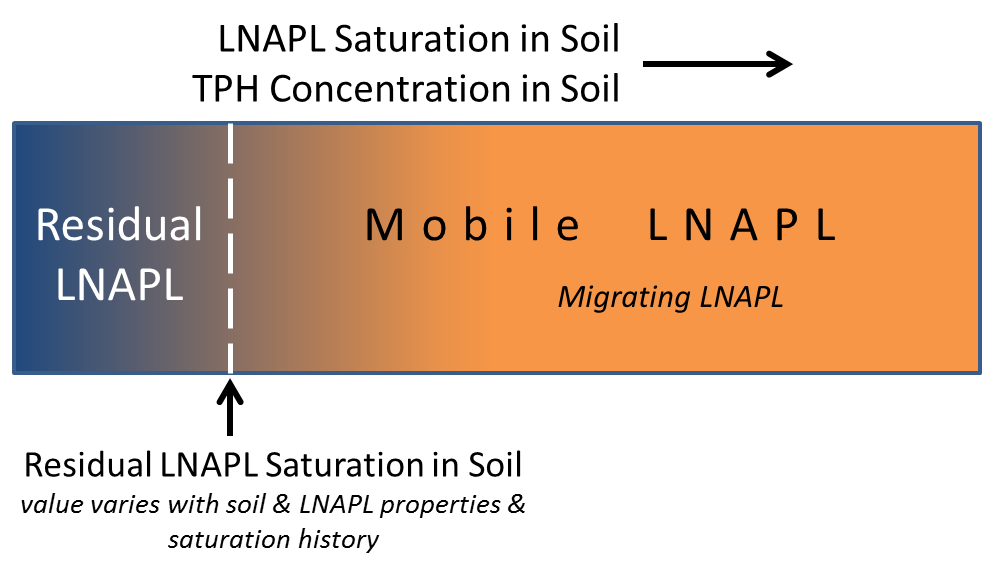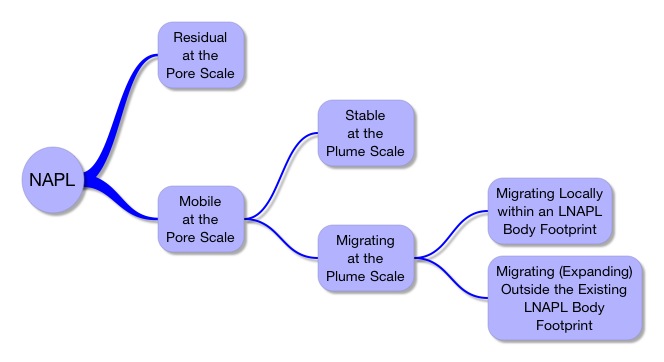Applied NAPL Science Review
Demystifying NAPL Science for the Remediation Manager
ANSR Scientific Review Board
J. Michael Hawthorne, PG, Board of Chairman, GEI Consultants Inc.
Mark Adamski, PG, BP Americas
Dr. Randall Charbeneau, University of Texas
Dr. Sanjay Garg, Shell Global Solutions (US) Inc.
Dr. Terrence Johnson, USEPA
Andrew J. Kirkman, PE, AECOM
Mark W. Malander, ExxonMobil Environmental Services
Applied NAPL Science Review (ANSR) is a scientific ejournal that provides insight into the science behind the characterization and remediation of Non-Aqueous Phase Liquids (NAPLs) using plain English. We welcome feedback, suggestions for future topics, questions, and recommended links to NAPL resources. All submittals should be sent to the editor.
Residual, Mobile and Migrating LNAPL
Andrew Kirkman, PE – AECOM
BACKGROUND: An explanation of residual versus mobile or migrating LNAPL is provided to clarify common terminology and describe a “weight-of-evidence” approach to evaluate potential LNAPL migration. Risks to human health and the environment from LNAPL typically occur from vapor migration into underground or surface structures or chemical dissolution into groundwater or surface water. If an LNAPL body is migrating, then the “risk footprint” can expand as, for example, LNAPL or one of its daughter phases migrate into surface water or utility corridors.
Definitions: LNAPL is either residual or mobile (ITRC, 2009).
Residual LNAPL – Immobile LNAPL present in soil pores. Residual LNAPL will not accumulate in a well or excavation installed across the LNAPL interval.
Mobile LNAPL – LNAPL present above residual saturation. If LNAPL accumulates in a well it is Mobile LNAPL.

Migrating LNAPL is actually a subset of Mobile LNAPL.
Migrating LNAPL – Mobile LNAPL moving through soil in any of three directions.

Migrating LNAPL in soil will stop migrating when it reaches equilibrium with adjacent pore scale threshold entry pressures and/or plume scale natural losses (e.g., volatilization, dissolution, biodegradation). LNAPL may migrate locally within a source zone without migrating at the LNAPL body boundaries. LNAPL that is migrating at the LNAPL body boundaries is often termed an “expanding LNAPL plume.”
Discussion: LNAPL bodies in granular porous media typically stabilize within 3 to 10 years based on model simulations (Golder, 2008). Stabilization occurs when the LNAPL pressure head is lower than the capillary threshold entry pressure of the granular porous media containing the LNAPL body (Charbeneau, 2007) and/or when the rate of natural losses via volatilization, dissolution and biodegradation equals or exceeds the migration rate (Sale, 2011; ITRC, 2009a).
Theoretically, calculation of LNAPL pressure heads, pore entry pressures and the rate of natural losses could be used to determine the potential for LNAPL migration. However, current models are imperfect estimates of these values. Consequently, a widely used approach to determine if LNAPL is migrating is a “weight-of-evidence” evaluation that considers all of the following (ASTM, 2006; Golder Associates, 2008; ITRC, 2009a; ITRC, 2009b; LSPA, 2008; Sale, 2011):
- Detection of LNAPL in previously unimpacted soils or wells (baseline LNAPL body dimensions based on soil screening during drilling, NAPL saturations, TPH in soil, laser induced fluorescence investigations, and/or other appropriate methods) – diagnostic of migrating LNAPL
- Changes in gauged LNAPL thickness including the detection or lack of detection of LNAPL:
- Persistence (repeatability) of LNAPL detection in wells under similar water table conditions
- Increasing apparent NAPL thickness (ANT) values in individual wells over time for equivalent calculated groundwater surface (CGWS) elevations
- LNAPL hydrogeologic condition and mobile LNAPL interval thickness determination via evaluation of ANT trends relative to CGWS elevations (see Confined LNAPL, Perched LNAPL, Diagnostic Gauge Plots)
- Comparison of modeled threshold entry pressures versus mobile LNAPL interval thicknesses at LNAPL body boundaries (with caution due to model input uncertainty)
- Statistically significant (e.g., Mann-Kendall test) increasing dissolved phase chemical concentration trends in wells prior to the appearance of LNAPL
- Evaluation of LNAPL detection and ANT trends versus air/NAPL and NAPL/water interface elevations and lithologies to evaluate the presence of preferential lithologic migration pathways (e.g., LNAPL in gravel)
- Evaluation of non-lithologic preferential migration pathways (e.g., fractures, utility trenches)
- Calculation of LNAPL natural losses (natural source zone depletion)
- Changes in LNAPL composition not attributable to weathering (e.g., LNAPL compositional change from gasoline to mixed gasoline/diesel)
- Evaluation of daughter-phase plume stabilities:
- Dissolved phase chemical concentrations versus CGWS elevations in wells to discern elevation related trends
- Evaluation of dissolved phase plume stability (e.g., temporal trends in plume footprint, mass flux discharge, individual well chemical concentrations)
- Evaluation of vapor phase extent stability
This checklist provides multiple lines of evidence to determine if your LNAPL is migrating at the plume scale. The result should then be documented in your LNAPL Conceptual Site Model (LCSM).
References:
ASTM (2006) Standard Guide for Development of Conceptual Site Models and Remediation Strategies for Light Nonaqueous-Phase Liquids Released to the Subsurface, ASTM International, Inc. Standard Guide No. E2531-06, 69 pp.
Charbeneau, Randall J. (2007) LNAPL Distribution and Recovery Model, Volume I: Distribution and Recovery of Petroleum Hydrocarbon Liquids in Porous Media, API Publication No. 4760, January 2007, 68 pp.
Golder (2008) Guidance on Assessment of Light Non-Aqueous Phase Liquid Mobility for Site Classification Purposes in British Columbia, Report Submitted to BC Ministry of Environment, October 9, 2008, 45 pp.
ITRC (2009a) Evaluating Natural Source Zone Depletion at Sites with LNAPL, The Interstate Technology & Regulatory Council LNAPLs Team, Technology Overview LNAPL-1, April 2009, 76 pp.
ITRC (2009b) Evaluating LNAPL Remedial Technologies for Achieving Project Goals, The Interstate Technology & Regulatory Council LNAPLs Team, Technical/Regulatory Guidance LNAPL-2, December 2009, 53 pp.
LSPA (2008) LNAPL and the Massachusetts Contingency Plan, Part II, LSP Association Technical Practices Committee, State of Massachusetts, July 2008, 41 pp.
Sale, Tom (2011) LNAPL Plume Stability and Attenuation Losses, 2011 AEHS Soil, Water, Energy and Air Conference, San Diego, CA, March 14, 2011.
Real World Limitations: A word of caution – LNAPL mobility is complex. For example, residual LNAPL saturation thresholds will vary for a given soil and LNAPL based on the initial saturation and subsequent saturation history of that soil. Over a short period of time it can be difficult to determine whether apparent changes in the LNAPL body footprint in wells represent migration or localized fluctuations above and below the residual saturation threshold value due to, for example, water table fluctuations.
